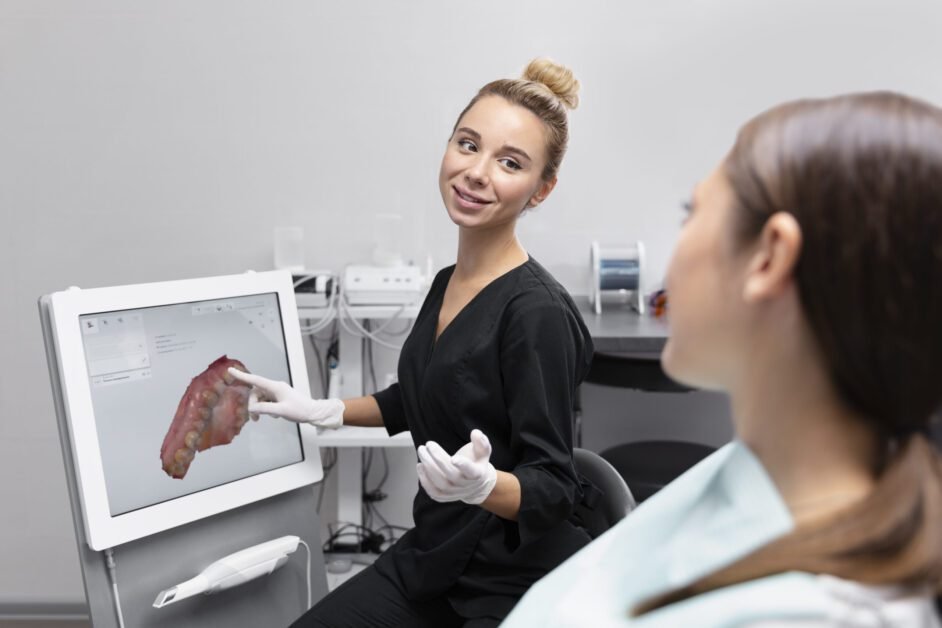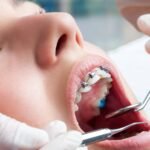Table of Contents
The Evolution of Orthodontic Technology

Orthodontic technology has come a long way over the years, continuously evolving to improve the treatment process and patient experience. The advancements in orthodontic technology have revolutionized the field, making treatments more efficient, precise, and comfortable for patients.
One significant development in orthodontic technology is the introduction of digital impressions. Gone are the days of uncomfortable and messy traditional impressions. Digital impressions utilize state-of-the-art scanning technology to create accurate 3D models of a patient’s teeth and gums. This not only eliminates the need for messy impression materials but also provides a more precise and detailed representation of the patient’s oral structures. With digital impressions, orthodontists can capture every nook and cranny of the teeth, resulting in a more accurate treatment plan and better-fitting appliances.
Additionally, digital impressions have the added advantage of streamlining the orthodontic process. The digital scans can be instantly sent to the lab, eliminating the need for physical models to be shipped. This not only saves time but also reduces the risk of errors or damage during transportation. Furthermore, the digital models can be easily stored and accessed, allowing orthodontists to track the progress of their patients’ treatment and make any necessary adjustments along the way. Overall, the evolution of orthodontic technology, particularly in the form of digital impressions, has revolutionized the way orthodontic treatments are planned and executed, leading to improved accuracy, efficiency, and patient satisfaction.
Advantages of Digital Impressions in Orthodontics

Digital impressions have revolutionized the field of orthodontics, offering numerous advantages over traditional impression techniques. One significant advantage is the increased accuracy and precision achieved with digital impressions. The use of advanced intraoral scanners allows for detailed and comprehensive 3D images of the patient’s teeth, gums, and surrounding structures. This level of precision ensures optimal treatment planning, resulting in more effective and predictable outcomes for patients.
In addition to accuracy, digital impressions also streamline the orthodontic process. Traditional impressions often involve a messy and uncomfortable process of using putty-like material to mold the patient’s teeth. With digital impressions, this step is eliminated, saving time and reducing patient discomfort. Furthermore, digital impressions can be quickly and easily sent electronically to the lab for creating orthodontic appliances, eliminating the need for physical shipping and allowing for faster turnaround times. This efficiency not only benefits patients but also improves workflow in orthodontic practices, increasing overall productivity.
Enhancing Accuracy and Precision with Digital Impressions

Digital impressions have revolutionized the field of orthodontics by enhancing the accuracy and precision of treatment planning and execution. With traditional methods, such as taking physical impressions using trays and dental putty, there is always a risk of distortion or inaccuracies. However, with digital impressions, a three-dimensional image of the patient’s teeth and gums can be captured with utmost precision, leaving no room for errors. This allows orthodontists to create more accurate treatment plans and fabricate customized braces or aligners that fit perfectly with the patient’s teeth.
The use of digital impressions also improves the precision of the orthodontic process by eliminating the need for manual measurements and adjustments. With the aid of advanced software, orthodontists can precisely analyze the digital models and make fine-tuned adjustments to achieve the desired tooth movement. This not only improves the overall accuracy of the treatment but also reduces the time and effort required for adjustments during the treatment process. Patients can thus benefit from a more efficient and streamlined orthodontic experience, with fewer chairside visits and shorter treatment durations.
Streamlining the Orthodontic Process with Digital Impressions
Digital impressions have revolutionized the orthodontic process by streamlining procedures and improving efficiency. With advances in technology, orthodontists can now capture highly accurate digital impressions of the patient’s teeth and gums, eliminating the need for messy traditional impression materials. This not only saves time but also reduces discomfort for the patients, making their overall experience more pleasant.
One of the main advantages of digital impressions is the speed at which they can be obtained. Traditional impressions often require multiple appointments, as patients may need to return for adjustments or corrections. However, with digital impressions, orthodontists can quickly capture precise images of the teeth and gums, allowing for faster treatment planning and implementation. This not only benefits the professionals but also the patients, who can achieve their desired results in a shorter period of time.
Reducing Discomfort and Improving Patient Experience with Digital Impressions
Digital impressions have revolutionized the orthodontic experience, significantly reducing discomfort and improving the overall patient experience. Traditional dental impressions often involve the use of trays filled with gooey materials, which can be uncomfortable and may cause gagging in some patients. With digital impressions, a small, handheld wand is used to capture precise 3D images of the patient’s mouth. This eliminates the need for messy materials and allows for a more comfortable and pleasant experience for the patient.
In addition to the physical discomfort, digital impressions also offer advantages in terms of accuracy and efficiency. The digital images can be instantly transferred to a computer, allowing orthodontists to quickly and accurately analyze the patient’s teeth. This helps to streamline the treatment process and ensures that the orthodontist has the most accurate information for treatment planning. Patients can also benefit from reduced chair time, as the digital images can be easily shared with other specialists or sent to dental laboratories for the fabrication of orthodontic appliances. With digital impressions, orthodontic treatment becomes smoother and more efficient, ultimately enhancing the overall patient experience.
| Advantage | Description |
|---|---|
| Faster and more efficient | Digital impressions are faster and more efficient than traditional impressions, reducing the amount of time patients need to spend in the dental chair1 |
| More accurate | Digital impressions are more accurate than traditional impressions, reducing the need for remakes and improving the fit of restorations1 |
| More comfortable | Digital impressions are more comfortable for patients than traditional impressions, eliminating the need for messy impression materials that can cause discomfort and gagging1 |
| Improved patient experience | Digital impressions can improve the overall patient experience by reducing discomfort and anxiety associated with traditional impressions1 |
How Digital Impressions Can Speed up Orthodontic Treatment
Digital impressions have revolutionized the field of orthodontics by significantly reducing treatment time for patients. Traditional impressions, which involved using putty-like materials to create molds of the teeth, were often time-consuming and uncomfortable for patients. With the advent of digital impressions, orthodontists can now capture highly accurate 3D images of the teeth and gums in a matter of minutes, greatly expediting the treatment process.
One of the ways in which digital impressions speed up orthodontic treatment is by eliminating the need for multiple physical appointments. In the past, patients would typically have to visit the orthodontist several times for impression taking, adjustments, and fittings. With digital impressions, however, these steps can be streamlined into a single appointment. The scan can be sent electronically to a laboratory where the aligners or braces are fabricated, eliminating the need for physical models and reducing the overall treatment time. This not only saves time for the patient but also allows orthodontists to see more patients and increase their efficiency.
The Role of 3D Imaging in Digital Impressions for Braces
The role of 3D imaging in digital impressions for braces cannot be overstated when it comes to orthodontic treatment. 3D imaging technology has revolutionized the way orthodontists plan and execute braces treatment, offering a level of precision and accuracy that was unimaginable in the past.
One of the key advantages of 3D imaging is the ability to capture detailed and comprehensive images of the patient’s teeth and jaw. This allows orthodontists to create digital models that accurately represent the patient’s unique dental anatomy, making treatment planning more customized and tailored to their specific needs. Furthermore, the high level of detail provided by 3D imaging allows orthodontists to detect even the smallest irregularities or abnormalities that may impact the success of the braces treatment. This enables them to make more informed decisions and adjustments throughout the course of the treatment, ensuring optimal results for the patient.
Exploring the Customization Options Enabled by Digital Impressions
Digital impressions have revolutionized the field of orthodontics by enabling a wide range of customization options. With traditional impressions, patients had limited control over the shape and size of their braces. However, digital impressions offer a more personalized approach, allowing orthodontists to create braces that are specifically tailored to each individual’s needs.
One of the key advantages of digital impressions is the ability to capture a highly accurate 3D model of the patient’s teeth. This allows orthodontists to make precise adjustments and modifications to the braces, ensuring a perfect fit and optimal alignment. By using advanced software, orthodontists can manipulate the virtual model of the patient’s teeth, analyzing every detail and making any necessary changes before the physical braces are produced. This level of customization not only improves the effectiveness of the treatment but also enhances the overall patient experience, as individuals can feel confident that their braces are uniquely designed to meet their specific orthodontic needs.
In addition to the customization of the braces themselves, digital impressions also offer the opportunity for more personalized treatment plans. Orthodontists can use the 3D model to simulate the predicted outcome of the treatment and communicate it to the patient. This visual representation allows patients to have a clear understanding of the expected results and enables them to actively participate in the treatment process. Orthodontists can also use the digital model to analyze how different treatment options will affect the patient’s teeth, providing a more comprehensive assessment and ultimately leading to more successful outcomes. Overall, the customization options enabled by digital impressions have revolutionized orthodontic treatment, providing patients with personalized and effective solutions for achieving their desired smiles.
Addressing Common Concerns and Misconceptions about Digital Impressions
Digital impressions have revolutionized the field of orthodontics, providing numerous benefits for both practitioners and patients. However, some concerns and misconceptions about this technology still persist. One common concern is the accuracy of digital impressions compared to traditional physical impressions. It is important to note that digital impressions have been found to be highly accurate, with studies showing comparable or even superior results in terms of capturing the accurate details of patients’ teeth and gums.
Another misconception is that digital impressions are time-consuming and may slow down the orthodontic process. In reality, digital impressions can actually save time for both the orthodontist and the patient. With digital impressions, the need for the time-consuming process of physically creating, mailing, and adjusting physical models is eliminated. This streamlines the overall orthodontic process and allows for faster treatment planning and communication between the orthodontist and the dental laboratory.
Addressing these concerns and misconceptions is vital to ensure that patients fully understand the benefits and advantages of digital impressions in orthodontics. By dispelling these misperceptions, patients can make informed decisions regarding their orthodontic treatment and experience the many advantages that this technology has to offer.
The Integration of Digital Impressions in Orthodontic Practices
Digital impressions have revolutionized the field of orthodontics, dramatically transforming the way orthodontic practices operate. With the integration of digital impressions, orthodontists can bid farewell to the messy and uncomfortable process of traditional impressions, and instead, capture precise, 3D images of the patient’s teeth and gums. This advanced technology allows for enhanced accuracy, improved communication, and streamlined treatment planning.
The integration of digital impressions in orthodontic practices has brought about numerous benefits, both for the orthodontist and the patients. One key advantage is the elimination of the need for physical molds, which were often prone to inaccuracies and distortion. With digital impressions, orthodontists can obtain highly accurate renderings of the teeth, gums, and surrounding structures, resulting in more precise treatment planning and better overall outcomes. Additionally, the digital images can be easily stored and accessed, improving communication and collaboration between the orthodontist and other dental professionals involved in the patient’s care. This seamless exchange of data enhances efficiency and ensures that everyone is on the same page throughout the treatment process.
The Impact of Digital Impressions on Treatment Planning and Communication
Digital impressions have revolutionized treatment planning and communication in the field of orthodontics. With the traditional method of taking physical impressions, the accuracy and precision were often compromised due to various factors such as patient movement, imprecise materials, and human error. However, with the advent of digital impressions, these issues have been mitigated, leading to more accurate treatment planning and improved communication between orthodontists and patients.
One of the key benefits of digital impressions is the ability to capture precise 3D images of a patient’s teeth and bite. This level of detail allows orthodontists to not only get a comprehensive view of the patient’s oral condition, but also to identify potential issues that may not have been visible with physical impressions. The digital images can be magnified, rotated, and adjusted for better visualization, enabling orthodontists to develop customized treatment plans that address each patient’s unique needs.
Furthermore, digital impressions facilitate seamless communication between orthodontists and their patients. By sharing the digital images with patients, orthodontists can effectively explain the treatment process, show the expected outcomes, and address any concerns or questions. Patients can also have a clearer understanding of their oral health and the proposed treatment, leading to increased trust and satisfaction. In addition, the digital files can be easily shared with other dental professionals involved in the patient’s care, ensuring streamlined communication and collaboration.
In conclusion, digital impressions have significantly impacted treatment planning and communication in orthodontics. The improved accuracy and precision of digital impressions enable orthodontists to develop customized treatment plans, while seamless communication with patients fosters trust and enhances the overall treatment experience. The integration of digital impressions in orthodontic practices has undoubtedly revolutionized the way orthodontic treatments are planned and communicated, leading to better outcomes and patient satisfaction.
The Future Potential of Digital Impressions in Orthodontics
Digital impressions have already revolutionized the field of orthodontics, providing numerous benefits in terms of efficiency, accuracy, and patient comfort. However, the future potential of digital impressions in orthodontics is even more exciting.
One area where digital impressions are expected to make significant advancements is in treatment planning. With the ability to capture highly detailed 3D images of the patient’s teeth and bite, orthodontists will have a more comprehensive understanding of the individual’s needs. This will allow for more precise treatment planning, ensuring optimal results and shorter treatment times. Additionally, advancements in artificial intelligence and machine learning may enable software to analyze digital impressions and provide automated treatment plans, further streamlining the process for orthodontic professionals.
Another aspect of the future potential of digital impressions in orthodontics is the customization options it provides. With digital impressions, orthodontists can easily modify and manipulate the virtual models, tailoring treatment plans to meet the specific needs of each patient. This level of customization helps to optimize treatment outcomes by considering factors such as individual tooth movements and facial aesthetics. Furthermore, with the integration of 3D printing technology, digital impressions can be used to create customized orthodontic appliances such as clear aligners or braces, enhancing comfort and aesthetics for the patient.
Overall, the future of digital impressions in orthodontics holds immense potential for advancing the field even further. The combination of advanced imaging technology, artificial intelligence, and customization options will enable orthodontists to provide more precise and efficient treatments, resulting in improved patient experiences and outcomes. As the technology continues to evolve, orthodontists will be able to stay at the forefront of the industry, providing cutting-edge care that meets the unique needs of each individual patient.
Patient Testimonials: Real-Life Experiences with Digital Impressions in Orthodontics
Digital impressions have revolutionized the field of orthodontics, providing patients with a more comfortable and efficient experience. Real-life experiences from patients who have undergone orthodontic treatment using digital impressions have highlighted the numerous benefits of this technology. One patient reported that the use of digital impressions eliminated the need for messy and uncomfortable traditional impressions, making the process much more pleasant. Another patient noted that the accuracy and precision of digital impressions resulted in a perfect fit for their braces, leading to faster and more effective treatment outcomes. These testimonials demonstrate the positive impact that digital impressions can have on the overall orthodontic experience.
Another aspect that patients have praised is the streamlined nature of the orthodontic process with digital impressions. Traditional procedures often involve multiple appointments and time-consuming steps. However, with digital impressions, patients have found that the entire process becomes more efficient and time-saving. One patient stated that the use of digital impressions significantly reduced the number of office visits required, allowing for more flexibility in their schedule. Additionally, the shortened treatment time due to the precise measurements obtained through digital impressions was highly appreciated by patients. The convenience and time-saving benefits associated with digital impressions offer patients a more streamlined and efficient orthodontic journey.
What is the difference between digital impressions and traditional impressions in orthodontics?
Digital impressions involve using advanced technology to create a virtual, 3D model of a patient’s teeth, eliminating the need for messy and uncomfortable traditional impressions.
How do digital impressions enhance accuracy and precision in orthodontics?
Digital impressions provide highly detailed and precise images of a patient’s teeth, allowing orthodontists to create more accurate treatment plans and ensure a better fit for orthodontic appliances.
Can digital impressions help speed up orthodontic treatment?
Yes, digital impressions can streamline the orthodontic process by eliminating the need for physical models and reducing the turnaround time for creating orthodontic appliances.
Are digital impressions more comfortable for patients compared to traditional impressions?
Absolutely. Digital impressions are more comfortable for patients as they eliminate the need for trays filled with impression material that can cause gagging or discomfort.
How does 3D imaging play a role in digital impressions for braces?
3D imaging allows orthodontists to visualize a patient’s teeth and jaws in a more comprehensive manner, aiding in the diagnosis, treatment planning, and monitoring of orthodontic progress.
What customization options are enabled by digital impressions in orthodontics?
Digital impressions allow for precise customization of orthodontic appliances, such as braces or aligners, ensuring a better fit and improved treatment outcomes.
What are some common concerns or misconceptions about digital impressions?
Some common concerns include the cost of implementing digital impression technology and the learning curve for orthodontic professionals. However, the benefits outweigh these concerns in terms of accuracy, patient comfort, and overall efficiency.
How are digital impressions integrated into orthodontic practices?
Digital impressions are integrated into orthodontic practices through the use of specialized scanners and software that create virtual models of a patient’s teeth, which can be stored, shared, and manipulated digitally.
How do digital impressions impact treatment planning and communication between orthodontists and their patients?
Digital impressions provide orthodontists with a more accurate and detailed representation of a patient’s teeth, facilitating better treatment planning and enabling clearer communication between the orthodontist and the patient.
What is the future potential of digital impressions in orthodontics?
The future potential of digital impressions in orthodontics includes advancements in technology, such as improved scanning devices and software, as well as potential integration with other orthodontic treatments, such as 3D printing of orthodontic appliances.
Can you provide some real-life patient testimonials about their experiences with digital impressions in orthodontics?
Unfortunately, the article does not include specific patient testimonials. However, patients have reported increased comfort, improved treatment outcomes, and a more efficient overall orthodontic experience with the use of digital impressions.











